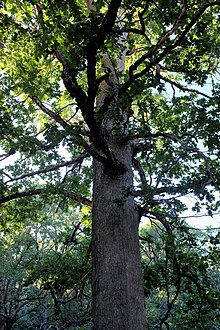en
names in breadcrumbs


The genus Quercus is one of the most significant cladistic groups of woody angiosperms in the Northern Hemisphere, based upon diversity as well as ecological dominance. Species of oaks are prominent members of many plant communities including: oak woodlands, temperate deciduous forests, matorral, pine-oak forests, chaparral-oak associations, tropical and subtropical savannas, tropical montane and premontane forests.
Fagaceae are woody trees and shrubs whose nut is enclosed in a shell-like casing. The Fagaceae family originated in Asia, first appearing in the fossil record during the Early Cretaceous, more than 100 million years ago. Subsequent radiation toward Europe and North America produced geographic dispersion as well as divergence of genera. The chromosomal composition across the entire family is remarkably similar (2n=24), but there are isolated triploid Quercus species. The extinct genus Dryophyllum, one of the earliest known Fagaceae, is believed to be the ancestor of modern oaks.
Based on molecular genetics analysis, the genus Quercus is estimated to have separated from Castanea about 60 million years ago. Oaks first appear in the fossil record in North America during the Paleogene between 55 to 50 million years b.p. Most interspecific separations occurred within the Quercus species between 22 and three million years ago. During this period, oaks became the most dominant tree type in the Fagaceae family.
Depending on the classification scheme, there are somewhere between 450 and 600 oak species; one of the chief points of confusion is the taxonomic status of many hybrid oaks. The geographical center of oak diversity is clearly in the Northern Hemisphere, particularly North America. At least 220 species occur on this continent, chiefly in Mexico and the USA. Mexico alone has 160 different oak species, 90 of which are endemic. Only one oak species occurs in South America, Quercus humboldtii, which is found in Columbia. After the Isthmus of Panama connected North and South America several million years ago, oaks propagated to the Andes, dating as early as 186,000 years before present., based upon pollen core records.
Quercus vulcanica is a species of flowering plant in the Fagaceae family.[2] It is referred to by the common name Kasnak oak, and is a rare species of tree native to Lebanon, Syria, and Turkey.[3][4] It is placed in section Quercus.[5]
Quercus vulcanica is highly valued in its native region as a source of lumber and also as an ornamental. It is a large tree up to 33 metres (108 feet) tall, with a trunk sometimes attaining 150 centimetres (59 inches) in diameter. The bark is gray and fissured. The leaves are up to 16 cm (6+1⁄4 in) long, egg-shaped with deep lobes, green on the top but yellow-green on the underside.[6][7]
 Quercus Vulcanica located in Isparta Province, Turkey
Quercus Vulcanica located in Isparta Province, Turkey Quercus vulcanica is a species of flowering plant in the Fagaceae family. It is referred to by the common name Kasnak oak, and is a rare species of tree native to Lebanon, Syria, and Turkey. It is placed in section Quercus.
Quercus vulcanica is highly valued in its native region as a source of lumber and also as an ornamental. It is a large tree up to 33 metres (108 feet) tall, with a trunk sometimes attaining 150 centimetres (59 inches) in diameter. The bark is gray and fissured. The leaves are up to 16 cm (6+1⁄4 in) long, egg-shaped with deep lobes, green on the top but yellow-green on the underside.